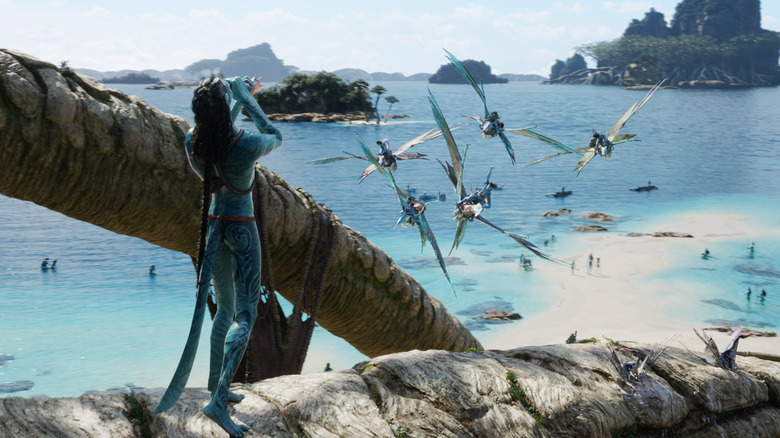The First Avatar Left Many Fans Depressed – Can The Way Of Water Cure What Ails Them?
Now that "Avatar: The Way of Water" is finally playing in theaters the world over, first-time travelers and returning visitors can now re-explore the dazzling world of Pandora. In 2009, when the original "Avatar" transported audiences to James Cameron's stunning, untouched planet, a huge number of fans became enamored with the ways of the Na'vi alien race. A lot of people already suffer from seasonal depression, but "Avatar" caused another kind of malaise when some moviegoers left Pandora and suddenly found themselves back in the real world. The condition was eventually labelled post-Avatar depression syndrome (PADS). After seeing a flourishing culture like the Na'vi that was so in tune with nature, some people had a hard time readjusting to the concrete jungle where their own homes were located.
That's certainly understandable, and the creative team responsible for the sequel are dedicated to delivering an even more immersive experience for fans that should cure any residual sadness they've had after waiting exactly thirteen years for a return trip to Pandora. Getting together with the Na'vi convert Jake Sully (Sam Worthington), his strong-willed wife Neytiri (Zoe Saldana) and their kids after all this time feels like a family reunion of sorts. Even seeing Colonel Quaritch again, in live action and avatar form, is a welcome sight. With the continuation of the story, "Avatar" fans have the remedy they need for what's been ailing them. In fact, the introduction to the remote ocean islands of Pandora transports us all to a vibrant underwater world that's arguably even more enchanting.
If you or anyone you know is having suicidal thoughts, please call the National Suicide Prevention Lifeline by dialing 988 or by calling 1-800-273-TALK (8255).
The Way of Water is a more joyous experience for fans
Early on in the sequel, the Sully family must leave their home with the Omatikaya clan after an avatar clone of Colonel Quaritch (Stephen Lang) and his fellow blue Marines begin to hunt them relentlessly. To keep the rainforest tribes safe, they travel a great distance to a small village occupied by the water clan of the Metkayina in hopes of finding refuge. The Metkayina clan agree to shelter them and teach the Sullys their ways and culture. In doing so, audiences are exposed to an entirely new way of life right alongside Jake, Neytiri, and their children Neteyam, Mo'Ak, Kiri, and little Tuk.
We learn the differences between the dragon banshees of the floating mountains and the seafaring flying-fish dragons known as Skimwings. Once each family member bonds with their new creature, they learn how to dive, allowing them to explore and connect with the magical underwater life of Pandora in ways never though possible.
Because of the astounding worldbuilding on display, the audience gets to live vicariously through the main characters, experiencing the underwater majesty without the danger of drowning. The ocean world of Pandora opens up even more when telepathic space whales, called the tulkun, are brought into the fold. The tulkun are sacred to the Metkayina, with many forming familial bonds with the massive creatures that last a lifetime. These sequences are exhilarating and invite audiences to fall even deeper in love with the vast, complex world that's been created. There's more to see and do on this faraway planet than ever before, and the themes of family and acceptance could deepen the level of affinity audiences have developed for Pandora's inhabitants.
Could the sequel cause another hangover?
Hopefully, the expansion of Cameron's world won't create an emotional backlash that ushers in a second wave of post-Avatar depression. That seems unlikely, seeing how the marine life of Pandora contains a more inviting array of creatures than the more threatening wildlife found among the "Avatar" rainforests. Simply put, the way of water is a much more welcoming environment to return to.
On top of that, the visual fix and emotional catharsis provided in "Avatar: The Way of Water" should be exactly what fans need to hold them over until the next film. Back in 2009, people didn't know if they'd ever get to return to the world of Pandora. When Disney's Animal Kingdom opened a Pandora theme park, being able to take a 3D ride on the back of a mountain banshee was a welcomed distraction for megafans, but it just wasn't quite the same. A sprawling yet surprisingly intimate sequel was just what the doctor ordered.
Are we more disconnected from nature today than we were in 2009 when Cameron's pro-environment epic hit theaters? We're certainly more aware of global warming now and the majority of Americans want the government to address the climate issue. To combat any potential emotional hangover this time around, remember that watching "Avatar: The Way of Water" doesn't have to be a passive experience. The imagination employed to make this film can inspire action. Go out and appreciate nature a little more, perhaps. Donate to Save the Whales or The Nature Conservancy, the latter of which is already working with Disney to keep our oceans amazing.
For now, being more active in-between "Avatar" films should help quell any longing to return to Pandora. Maybe Cameron's action film is really a call-to-action film in disguise.


